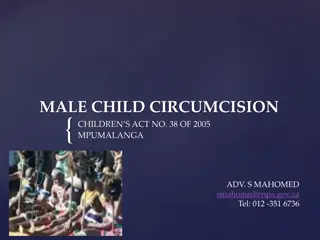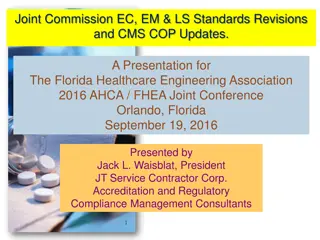Overview of Norms and Standards Compliance Inspections in Mpumalanga Province
This information outlines the vision, mission, mandate, appointment of inspectors, types of inspections, inspection processes, and methodology related to norms and standards compliance inspections in Mpumalanga Province. It also delves into the objectives of the Office of Health Standards Compliance (OHSC), emphasizing the protection and promotion of health and safety in healthcare establishments through monitoring and enforcement. The different types of inspections, including routine, additional, and risk-based inspections, are detailed, highlighting the focus on ensuring safe and quality healthcare for all South Africans.
Download Presentation

Please find below an Image/Link to download the presentation.
The content on the website is provided AS IS for your information and personal use only. It may not be sold, licensed, or shared on other websites without obtaining consent from the author.If you encounter any issues during the download, it is possible that the publisher has removed the file from their server.
You are allowed to download the files provided on this website for personal or commercial use, subject to the condition that they are used lawfully. All files are the property of their respective owners.
The content on the website is provided AS IS for your information and personal use only. It may not be sold, licensed, or shared on other websites without obtaining consent from the author.
E N D
Presentation Transcript
NORMS AND STANDARDS COMPLIANCE NORMS AND STANDARDS COMPLIANCE INSPECTIONS INSPECTIONS 16 16 17 January 2019 17 January 2019 Mpumalanga Province Mpumalanga Province 1
OUTLINE 1. VISION & MISSION OF THE OHSC 2. MANDATE OF THE OHSC 3. APPOINTMENT OF INSPECTORS 4. TYPES OF INSPECTIONS 5. INSPECTION PROCESSES & METHODOLOGY 6. SCORING & RISK RATING 7. Code of conduct 8. Reports 2
VISION AND MISSION OF THE OHSC VISION Safe and Quality Healthcare for all South Africans MISSION We act independently, impartially, fairly and fearlessly on behalf of the people of South Africa in guiding, monitoring and enforcing healthcare, safety and quality standards in health establishments 3
MANDATE OF THE OHSC s78. Objects of the Office The objects of the office are to protect and promote the health and safety of users of health services by: Monitoring establishments with prescribed norms and standards. and enforcing compliance by health Ensuring consideration, investigation and disposal of complaints relating to breaches of norms and standards. 4
MANDATE OF THE OHSC continued This interdependent priority outcomes. These are: mandate contributes to two distinct but Reductions in avoidable mortality, morbidity and harm within health establishments through reliable and safe health services. Improvements in the availability, responsiveness and acceptability of health care standards. 5
TYPES OF INSPECTIONS Routine Inspections: Every health establishment to be inspected according to the National Health Act 61 of 2003 as amended once in four (4) years. Additional Inspections: Additional Inspections: An inspector may, at any time, subject to section 82(1) of the Act, conduct an additional inspection, provided that he or she has reasonable grounds to believe that Such an inspection is needed to establish whether non-compliance has been remedied within the health establishment; The health establishment is contravening the act or any relevant regulations; There are serious breaches of norms and standards, based on the indicators of risk; or The ombudsman findings demonstrate that continued exposure to the health care services provided by health establishment may pose a severe risk to users or health care personnel. 6
TYPES OF INSPECTIONS continued Risk-based Inspections: Triggered by Early Warning System(EWS), targeted for persistent or critical non compliance and Ombudsman findings. 7
Appointment of inspectors In terms of section 80(2) of the Act an inspector must be a qualified health professional, who is registered with the Allied Health Professions, the Health Professions Council of South Africa, the South African Nursing Council, or the South African Pharmacy Council, referred to in the definition of "statutory health professional council" in section 1 of the Act
Appointment of inspectors ( Cont.) The Chief Executive Officer must issue a person who has been appointed as an inspector in terms of section 80(2) of the Act with a certificate of appointment as an inspector, in accordance with section 80(3) of the Act, once the person has successfully completed a minimum training programme approved by the Office.
Appointment of inspectors ( Cont.) The certificate of appointment as an inspector must include, at a minimum, the following information: (a) The name and surname of the inspector; a unique identification number supplied by the Office; (b) the date of issuance; the address and contact details of the Office; (c) a form of photographic identification. The signature of the Chief Executive Officer.
Inspection strategy An annual inspection strategy guide the inspection activities of the Office. The annual inspection strategy will be published on the Office s public website, and include the following: 1. An approach to prioritising, scheduling and conducting inspections; and 2. resources for the implementation of the inspection strategy.
Procedure Manual The Office developed an inspection procedure manual and tools for inspectors to ensure that Inspections are carried out in a consistent, fair, equitable and transparent manner
Code of conduct Code of conduct for inspectors as in section 80(2) of the Act states that A copy of the code of conduct for inspectors referred to in sub-regulation (1), must be signed by all the inspectors prior to the commencement of their duties and will be publish in Government Gazette.
Inspection Process An inspector must, before commencing with an inspection contemplated in section 82 of the Act, issue a notice of inspection to the health establishment. The notice of inspection should include, at least, the following information: (a) the purpose of the inspection; (b)the date of the inspection; (c) the estimated duration; (d)The number of authorised personnel expected to take part in the inspection; (e)The contact details of the inspector primarily responsible for the inspection; and
Inspection Process The responsibilities of the health establishment. During an inspection, the health establishment must make available the necessary staff, resources and space to allow inspectors to complete the inspection in a timely and expeditious manner. (3) An inspector may question any user, occupant, health care personnel or any person on the premises of a health establishment about any information that is relevant to the inspection, or require the person in charge to produce any document, record or material for inspection. (4) The person in charge may provide the inspector with any relevant information, documents, records, objects or materials for the inspector's consideration during the inspection visit.
Inspection Process An inspector must prepare an inspection plan, which sets out a clear approach to carrying Out the inspection for each health establishment to be inspected. The inspection plan referred to in sub- regulation (4) must be appended to the Notice of Inspection referred to in sub- regulation 13.
INSPECTION PROCESSES & METHODOLOGY Inspections methods include: I. Observation II. Documents review III. Patient record analysis IV. Patient and staff interviews Evidence is collected for both compliant and non compliant measures. 17
SCORING & RISK RATING Classification of Measures RISK RATING Cut off levels SCORING Compliant = 1 EXTREME HIGH 100% Non compliant = 0 Not Applicable (N/A) needs VITAL Above 90% substantive evidence ESSENTIAL MEDIUM Above 80% No partial compliance Any Extreme measure failed will result in over all non compliance of the HE DEVELOPMENTAL lOW Above 60%
Proposed Compliance Status Framework Score Grade Risk Outcome Inspection Rating frequency A <20% Good 4 Yearly 80% + B 21-30% Satisfactory 2 Yearly 70-79% C 31-40% Fair 1 Yearly 60-69% D >41% Poor 6 -12 months <59% 19
Types of Health Establishment 1.PUBLIC HOSPITALS 2.PUBLIC CLINICS AND CHCS 3.PRIVATE HOSPITALS AND CLINICS 20
Functional areas Hospital Hospital Clinical services Non Clinical services Inpatient services Out patient services Management CEO/ Hospital Manager Clinical Management Group Infection control Medical ward x 3 Surgical ward x 3 Maternity ward Paediatric ward x 3 Newborns Neonatal ICU TB Isolation room HIV/AIDS Intensive care or high care units x 4 Operating theatre x4 Procedure room Psychiatric ward: Acute ward Child and adolescent unit Forensic Obervation unit Long term ward State patient unit Antenatal clinic Oral health Overnight/short stay ward Outpatient department Accident and Emergency unit Procedure room Administrative services HR management Procurement Occupational risk management Communications/PRO Management information systems Case management Occupational Health & Safety Financial management Facility management Waiting areas Record archive/department Reception, help desk and Switchboard Public areas Clinical support services Blood services Laboratory Health technology services Pharmacy Radiology Medical Supplies Therapeutic support services: Physio Occupational Speech Optometry Support services Facility Infrastructure Mortuary services CSSD Cleaning services Food services Laundry services Maintenance services including gardens Waste management Transport services Security services 22
Functional areas of a Clinic Clinic Non Clinical services Clinical services Management Outpatient services Clinic manager/ HOD Clinical services General services Clinical support services Maintenance and support Pharmacy/ Medicine cupboard 23
Functional areas of a CHC Non Clinical services CHC Clinical services Management Outpatient services CHC manager Accident and Emergency unit Maternity Obstetrics unit Clinical services Generic ward Support services Maintance and support Clinical support services Pharmacy/Medicine cupboard 24
InspectionReports The following reports will be given to the person in charge within 20 working days post inspection: I. II. Functional area technical report III. Evidence report IV. Quality Improvement template Standard technical report Comments relating to the findings will be expected from the health establishment within 20 working days post preliminary feedback meeting 25
INSPECTION PROCESS Inspections assess: Insert picture Inspection Programme process flow Initiating an Inspection systems, processes and procedures that promote and ensure quality health services Conducting back ground document review Plan Preparing for on-site Inspection evidence that quality and safety are seen as important activities (logistics) Conducting on-site Inspection activities Do that managers put in place systems to ensure basic quality of care is provided within the health establishment the Inspection report Check Preparing, approving and distributing Completing the Inspection findings what is seen at the time of inspection and not the reason why Conducting Inspection follow up Act 10 ISO 19011:2002 26
. In conclusions In conclusions We want to ensure sure that the health care system in South Africa We want to ensure sure that the health care system in South Africa provide the best quality health care possible provide the best quality health care possible 27























